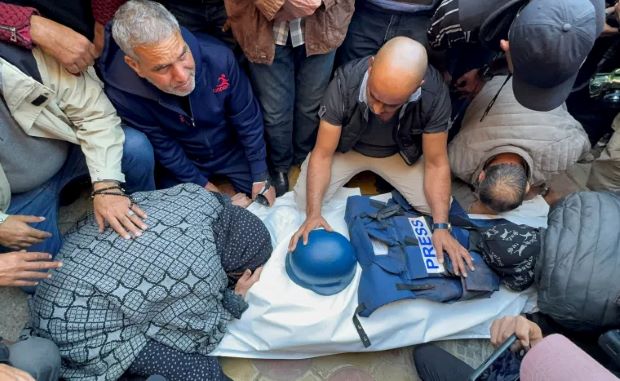Journalists an endangered species in war zones
By Thalif Deen
The devastating war in Gaza has proved once again that journalists are an endangered species—particularly when covering civil wars and military conflicts—where scores have been targeted or killed.
Perhaps it is the second most dangerous profession after the military, followed by UN peacekeepers and humanitarian workers in war zones.
As of December 19, at least 68 journalists and media workers were among the more than 20,000 people killed since the Israel-Gaza war began on October 7, plus 1,200 in Israel.
Although the number of journalists killed is minuscule, the threats against the media have severely restricted news coverage from Gaza.
The New York-based Committee to Protect Journalists (CPJ) said last week that reporting from the front lines of a conflict is one of the most challenging assignments a journalist can undertake.
“It is important that journalists prepare before an assignment to understand the environment they are entering—and the deadly threats they may face”.
The CPJ said it is deeply saddened by the killing of Al-Jazeera Arabic camera operator Samer Abu Daqqa and the injuries suffered by his colleague, Al-Jazeera Gaza bureau chief Wael Dahdouh, who was injured in what was believed to be an Israeli drone strike in Khan Yunis, southern Gaza, on December 15.
The CPJ called on international authorities to conduct an independent investigation into the attack to hold the perpetrators to account.
The wife, son, daughter and grandson of Wael Dahdouh, were also killed in an Israeli air raid.
Asked about the inability of the Palestinian Red Crescent to reach the injured cameraman, UN Spokesperson Stephane Dujarric said last week, “It is critical that journalists be able to do their work free from violent attacks, free from violence”.
“I mean, as in any conflict, the Secretary-General is not the one with his hands on the trigger. And we said this over and over again, the guns must be silenced.”
“We’ve called for a humanitarian ceasefire, and we have called for the guns to be silenced in conflicts all over the world where journalists are being killed, where UN facilities are being destroyed, and where innocent civilians are paying the price,” said Dujarric.
CPJ is also calling for a transparent investigation into the December 15 beating of Turkish state-owned Anadolu Agency photojournalist Mustafa Alkharouf by Israeli soldiers.
Alkharouf was covering Friday prayers near Al-Aqsa Mosque in East Jerusalem when a group of Israeli police and soldiers attacked him, according to Anadolu Agency, footage shared by The Union of Journalists in Israel, and other reports.
CPJ has also called for accountability in the case of Reuters journalist Issam Abdallah, who was killed by an Israeli shell, according to the reports by Amnesty International, Human Rights Watch, Reuters, and Agence France-Press.
In a pointed warning on news coverage, CPJ said journalists covering today’s conflicts may confront specialized weapons, indiscriminate shelling, and damaged crucial infrastructure.
Essential personal protective equipment may be difficult to obtain on the ground or to transport across borders. The emotional toll of living in and reporting on a conflict zone may also affect the mental health of journalists.
Journalists should complete a risk assessment before entering a conflict zone to identify potential battlefield hazards and prepare equipment, training, and emergency procedures, CPJ advised.
Meanwhile, in his year-end press conference on December 22, UN Secretary-General António Guterres said, “136 of our colleagues in Gaza have been killed in 75 days—something we have never seen in the history of the United Nations.”
“Nowhere is safe in Gaza”, he declared.
In his remarks to the media, Guterres said over the last weeks and days, there has been no significant change in the way the war has been unfolding in Gaza.
“There is no effective protection of civilians. Intense Israeli bombardment and ground operations continue. More than 20,000 Palestinians have reportedly been killed, the vast majority women and children”.
Meanwhile, Hamas and other Palestinian factions continue to fire rockets from Gaza into Israel. And some 1.9 million people—85 per cent of Gaza’s population—have been forced from their homes, he said.
-Thalif Deen, author of ‘No Comment – and Don’t Quote Me on That’, is Editor-at-Large at the Berlin-based IDN where this article was originally featured. An ex-UN staffer and a former member of the Sri Lanka delegation to the UN General Assembly sessions, he is a Fulbright scholar with a Master’s Degree in Journalism from Columbia University, New York, and shared the gold medal twice (2012-2013) for excellence in UN reporting awarded by the UN Correspondents Association (UNCA)



Comments are closed, but trackbacks and pingbacks are open.